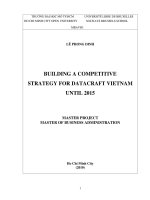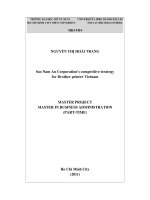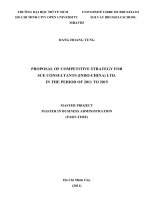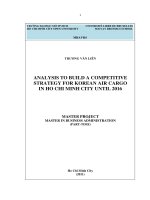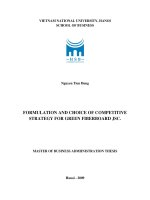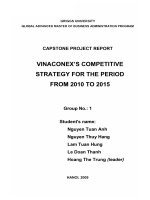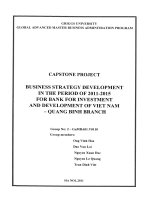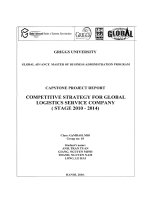Proposal of competitive strategy for SCE consultants (Indo China) LTD. in the period of 2011 to 2015
Bạn đang xem bản rút gọn của tài liệu. Xem và tải ngay bản đầy đủ của tài liệu tại đây (2.42 MB, 88 trang )
TRƯỜNG ĐẠI HỌC MỞ TP. HCM UNIVERSITÉ LIBRE DE BRUXELLES
HO CHI MINH CITY OPEN UNIVERSITY SOLVAY BRUSSELS SCHOOL
MBAVB3
DANG HOANG TUNG
PROPOSAL OF COMPETITIVE STRATEGY FOR
SCE CONSULTANTS (INDO-CHINA) LTD.
IN THE PERIOD OF 2011 TO 2015
MASTER PROJECT
MASTER IN BUSINESS ADMINISTRATION
(PART-TIME)
Ho Chi Minh City
(2011)
i
Acknowledgement
I wish to express my loving thanks to my parents and wife for their spiritual support and
encouragement during my study.
I wish to extend my gratitude to Dr. Nguyen Quyet Thang for his valuable advice and help.
Finally, thanks to all friends who share with me joy, happiness and sadness.
ii
Declaration
This thesis is a presentation of my own study. Wherever contributions of
others are involved, every effort is made to indicate this clearly, with due
reference to the literature, and acknowledgement of collaborative research
and discussions.
The work was done under the guidance of Dr. Nguyen Quyet Thang, under
the framework of the Master program in Business Administration – The join
Master Program between Solvay Brussels School (Belgium) and Ho Chi
Minh City Open University (Vietnam).
The work was completed in February 2011, in Ho Chi Minh City – Vietnam
(candidate’s name and signature)
DANG HOANG TUNG
In my capacity as supervisor of the candidate’s thesis, I certify that the above
statements are true to the best of my knowledge.
(tutor’s name and signature)
Dr. NGUYEN QUYET THANG
Date:
iii
Abstract
Positioning in consultancy of high-rise building segment, in recent years SCE
Consultants (Indo-China) Ltd is considered a successful company in terms of high
growth rate. Nevertheless, as other consultant companies, SCE Consultants (Indo-
China) Ltd is facing the question of how to develop in the environment with fiercer and
fiercer competition. Hence, the purpose of this study, designing a competitive strategy
for the company, becomes more necessary and crucial.
In this study, based on the general process of strategy formulation, the most appropriate
strategy for the company to develop will be found out. Firstly, an external scanning
relied on macro environment and industry environment analysis to identify
opportunities and threats for the company is carried out. Secondly, the company’s
factors such as organizational structure, human resource and business activities… are
examined to reveal strengths and weaknesses of the company. Thirdly, derived from
the determined strengths, weaknesses, opportunities and threats, the most appropriate
competitive strategy for the company is developed. Finally, recommendations that the
company should pay attention to in order to successfully implement the proposed
strategy are presented.
iv
Table of Content
CHAPTER 1: INTRODUCTION 1
1.1. Rationale of the study 1
1.2. Problem statement 1
1.3. Objectives 2
1.4. Scope and limitation of study 2
1.5. Methodology and framework of the study 2
1.6. Structure of the study 4
CHAPTER 2: LITERATURE REVIEW 6
2.1. Competitive advantage 6
2.1.1. Definition 6
2.1.2. Generic building blocks of competitive advantage 7
2.2. Competitive strategy 8
2.2.1. Definition 8
2.2.2. Three levels of strategy 10
2.3. Process of strategic management 12
2.4. Strategy formulation process 13
2.4.1. Vision, mission and goals 13
2.4.2. External analysis 13
2.4.3. Internal analysis 17
2.4.4. Strategy formulation and strategic choice 18
CHAPTER 3: EXTERNAL ENVIRONMENT ANALYSIS 20
3.1. Vietnam construction industry overview 20
3.1.1. Housing construction 20
3.1.2. Infrastructure construction 20
3.1.3. Commercial construction 22
3.1.4. Retail and industry construction 22
3.2. Macro environment analysis 23
3.2.1. Political and regulatory factors 23
3.2.2. Economic factors 24
3.2.3. Social, culture and demographic factors 29
3.2.4. Technological factors 31
v
3.2.5. International factors 32
3.3. Industry environment analysis 33
3.3.1. Definition 34
3.3.2. Porter’s five force analysis 34
3.3.3. Conclusion 37
CHAPTER 4: INTERNAL ENVIRONMENT ANALYSIS 39
4.1. Introduction of SCE Consultants (Indo-China) Ltd 39
4.2. Company’s Vision, Mission and Core values 40
4.3. Organizational structure 41
4.4. Human resource management 43
4.5. Business activities 44
4.5.1. Current services 44
4.5.2. Core clients 49
4.5.3. Pricing strategy 50
4.5.4. Business achievement 51
4.6. SWOT analysis 51
4.6.1. Opportunities 52
4.6.2. Threats 53
4.6.3. Strength 53
4.6.4. Weakness 53
4.6.5. SWOT matrix 54
CHAPTER 5: FORMULATION COMPETITIVE STRATEGY 55
5.1. Foundation of the strategy 55
5.1.1. What is to be satisfied? (Customer needs and product differentiation) 55
5.1.2. Who is to be satisfied? (Customer groups and market segmentation) 55
5.1.3. How customer needs are to be satisfied? (Distinctive competences) 56
5.2. Competitive strategy for SCE 56
5.2.1. Generic competitive strategy 56
5.2.2. Proposed competitive strategy in the period of 2011 – 2015 59
CHAPTER 6: CONCLUSIONS AND RECOMMENDATIONS 68
6.1. Conclusions 68
6.2. Recommendations 69
vi
6.3. Limitation of the project 70
APPENDIX 71
Appendix A: Questionnaires for direct interview with directors and managers of SCE
Consultants (Indo-China) Ltd. Company 71
Appendix B: Questionnaires for direct interview with directors and managers of key
clients of SCE Consultants (Indo-China) Ltd. Company 73
Appendix C: Questionnaires for direct interview with directors and managers of
partners of SCE Consultants (Indo-China) Ltd. Company 75
REFERENCES 77
vii
List of Figures
Figure 1.1 Frame work of study 3
Figure 2.1 Value creation to consumer and producer 6
Figure 2.2 Strategic planning process 12
Figure 2.3 Porter’s five force model for industry analysis 15
Figure 3.1 GDP and GDP per capita in the period of 2005-2015 25
Figure 3.2 Inflation in the period of 2005-2015 26
Figure 3.3 FDI in the period of 2005-2015 27
Figure 3.4 Top 10 FDI investors in the period of 2005-2015 28
Figure 3.5 Exchange rates (at year-end) in the period of 2005-2015 29
Figure 3.6 Rising urbanization level 30
Figure 3.7 Porter’s model applied to the case of SCE 38
Figure 4.1 Manpower of SCE (at year-end) in the period of 2005-2010 41
Figure 4.2 SCE’s organizational chart in 2010 42
Figure 4.3 SCE’s service line _ Service line 1 (SL1) 45
Figure 4.4 SCE’s service line _ Service line 2 (SL2) 47
Figure 5.1 SCE’s generic strategy 59
Figure 5.2 Proposed competitive strategy for SCE 59
viii
List of Tables
Table 2.1 Generic competitive strategies and required competencies 19
Table 3.1 Top 10 major apartment building projects in HCMC in the period
of 2007-2010 20
Table 3.2 Top 10 priority projects in the period 2005-2010 21
Table 3.3 Top 10 major office developments in HCMC 22
Table 3.4 Top 10 major industrial developments in the period 2007-2010 23
Table 3.5 Top 10 highest buildings in Vietnam 32
Table 4.1 Corporate milestones 39
Table 4.2 SWOT matrix of SCE 54
ix
Abbreviations
(In order of appearance)
C&S Civil and Structural
SCE SCE Consultants (Indo-China) Ltd (Vietnamese branch)
FDI Foreign direct investment
CRM Customer relationship management
HCMC Ho Chi Minh City
R&D Research and development
CAGR Compound annual growth rate
sqm Square meter
CBRE CB Richard Ellis Co. Ltd
ASEAN Association of South East Asian Nations
WTO World Trade Organization
IMF International Monetary Fund
GDP Gross domestic product
CFIS Center for Foreign Investment Studies (University of Economics Ho Chi
Minh City)
pa Per annual
MOC Ministry of Construction
MPI Ministry of Planning and Investment
IT Information technology
HR Human resource
SCEs SCE corporate including SCE Singapore and SCE Vietnam
GD General Director
SL1 Service line 1 (refer to figure 4.3)
PM Project Management
SL2 Service line 2 (refer to figure 4.4)
ODA Official development assistance
1
CHAPTER 1: INTRODUCTION
1.1. Rationale of the study
Since the 1960s, the construction industry has contributed a great part to the national
economic development; it accounted for 9.0% of GDP annually over the period of 2005
- 2009
[8]. Civil and Structural (C&S) works in general as well as C&S consultancy in
particular are integral parts of any construction project and their performance have
been greatly affecting overall project quality. Moreover, it can be realized that most of
big and important projects with foreign investment capital have been designed and built
by foreign enterprises and such kind of projects is rapidly increasing.
Despite of owning competitive advantages in quality manpower, technology
knowledge, professional experiences and modern equipments several foreign
consultants including C&S ones are facing losses and have no choice but to exit the
market due to fiercer and fiercer competitions. Therefore, all players are forced to
enhance their competences and plan properly for survival and development.
SCE Consultants (Indo-China) Ltd, hereafter called SCE, was established in 2005 as an
entry strategy of its mother company headquartered in Singapore, SCE Consultant (Pte)
Ltd, into Vietnam-Laos-Cambodia market. SCE is providing services on C&S
consultancy, specializing on high-rise buildings segment, which is believed blooming
now and future. Like others, SCE is standing in front of tough competition, thus an
appropriate strategy is so necessary and vital.
1.2. Problem statement
Recent years has recorded strong flows of FDI into the country, especially in real estate
sector, and improvement on economic environment both which create plentiful
opportunities for developers, constructors and consultant firms. Although SCE has been
achieving faster and faster growth thanks to the company’s own professional capability,
2
good reputation and expertise support of SCE Singapore, the Vietnamese branch has
not been well known and still accounts for a limited market share. How to enhance its
current position and exploit superior chances for long term sustainable development has
become strategic issue.
The thesis aims to build up a competitive strategy as a recommendation for the
company to move forward in the period of 2011 to 2015. The study will apply theories
of competitive strategy by Michael Porter, differentiation management and CRM-
customer satisfaction. Study methodology is also including a qualitative research on
customer satisfaction and an in-depth analysis on information found.
1.3. Objectives
This study targets to find out proper answers to below questions:
1. How is company’s service quality in assessments of SCE’s clients and partners?
2. What should the company do to satisfy expectations of its’s clients?
3. How to improve company’s competitive advantages?
1.4. Scope and limitation of study
This study is about the SCE, specifically about C&S consultancy, the main service of
the company. It focuses on formulate the competitive strategy for the company in the
medium term.
The depth of this study depends partly on the availability of the key data of the
Vietnamese economy and the construction industry in general, especially of SCE. It
also depends on cooperation from the company and faces resources constraints.
1.5. Methodology and framework of the study
This study will begin with a review of literature which concerns the strategic
management process, particularly the process of strategy formulation. It also mentions
3
to the concepts and principles of the Porter’s model to analyze the competitive
environment of the industry.
The framework of this study can be illustrated by figure 1.1.
Figure 1.1: Framework of the study
Necessary data for this study were collected from 2 main sources:
GENERATION, EVALUATION, AND SELECTION OF
THE BEST STRATEGY
CONCLUSIONS AND RECOMMENDATIONS
PROBLEM
Strategy formulation process
Porter’s industry analysis model
SITUATION ANALYSIS
Scan external
environment
Evaluate
current
performance
Scan internal
environment
Opportunities
Threats
Strengths
Weaknesses
Analyze the
competitive
environment
LITERATURE REVIEW
4
• Primary data: Interviews in-depth with 12 directors and top managers of SCE
Vietnam, SCE Singapore, SCE’s clients and partners. And other relevant data
were also collected.
• Secondary data: Relevant data about the construction industry and the country’s
economy will be collected from the General Statistics Office of Vietnam,
Statistics Office, Ministry of Construction, Ho Chi Minh City (HCMC)
Department of Construction as well as from newspapers, media, internet, etc.
1.6. Structure of the study
The study is organized as follows:
Chapter 1 provides an introduction including the rationale of the study, identification of
the problem, the objectives, the scope and limitations as well as the methodology and
framework of the study.
Chapter 2 shows the literature review of the topic being considered. This will
encompass the fundamental ideas on strategy, strategic management and strategy
formulation process as well as the Porter’s model for analyzing industry.
Chapter 3 provides an analysis of external factors that help indicate the company’s
strategic position. The main contents of the chapter will deal with the current situation
and strategic orientation for the construction industry in the future. It also mentions
about the structural analysis of the construction industry, the main area of competition
of SCE.
Chapter 4 deals with the current analysis of SCE in terms of organizational structure,
human resource, business activities… The ultimate goal of the chapter is to identify
strengths and weaknesses of the company in order to locate its present competitive
position.
5
Chapter 5 is devoted to the expected outcome of the study to develop the strategic
alternatives based on the analysis from previous parts that will help the company
achieve outstanding performance in the coming years.
Finally, Chapter 6 deals with practical recommendations on the implementation of the
selected strategy.
6
CHAPTER 2: LITERATURE REVIEW
2.1. Competitive advantage
2.1.1. Definition
There are not many clear definitions of competitive advantage in textbooks of strategic
management.
Hill and Jones [1] say a company has a competitive advantage when its profit rate is
higher than the average for its industry and it can sustain this advantage to maintain
high profit rate over a number of years.
This definition uses profit rate as a measurement to rate the competitive advantage. In
other view, we can say that a product has competitive advantage when it was chosen by
a customer after his or her comparing among several similar products. This definition is
constructed in a competition context. It can give us better idea about competitive
advantage in a competitive environment.
Figure 2.1: Value creation to consumer and producer
The key point of competitive advantage lies in the concept of value creation. The value
of a product to a consumer may be V, the price that company can charge under
competitive pressure may be P, and the cost of producing that product is C. The
V
V = Value to consumer
P = Price
C = Cost of production
V-P = Consumer surplus
P-C = Profit margin
P
C
V - P
P - C
C
7
company profit is equal to P-C while the consumer benefit equal to V-P. For two similar
products with the same price P
1
= P
2
, product 1 has competitive advantage if V
1
>V
2
. In
other words, product 1 has competitive advantage because it brings greater value to
customer. This will be the focal point for us to formulate strategy and implementation
plan.
2.1.2. Generic building blocks of competitive advantage
Many factors contribute to competitive advantage of a company. But in general, they
can be classified into four generic categories:
• Efficiency: is the ratio between a company’s outputs to its input. The more
efficient the company, the more outputs it can produce from certain units of input
or in other words, it can produce the same amount of outputs from less inputs, thus
efficiency helps company achieve low cost competitive advantage. The most
important component of efficiency for a company is employees’ productivity.
With other factors hold constant, the company with its highest employee
productivity typically has the lowest cost of production.
• Quality: high quality of a product or service has strong contribution to company’s
competitive advantage. First, high product quality give positive perception of
customer about product, increase customer preference thus company can charge
higher price for higher quality. Second, high quality comes from greater
efficiency and lower defective rate. Low defective rate requires less time to fix
substandard product and reduce the labor cost for fixing it. These two effects
combined bring company higher profit rate.
• Innovation: innovation can be defined as new way company manufacture
product. Innovation can be in the form of process, product design, management
system, organization structure or even in the business practice of the company.
According to Hill and Jones [1], innovation can be the most important component
8
of competitive advantage. It is the single most important to the differentiation of
product or process that the competitors do not have. Uniqueness can allow
company to charge higher price for its products. Example of product innovation is
Apple for Iphone, Hewllet Packard for lazer printer. They are the poineer
company in each kind of product. When competitor immitate the product, Apple
and HP have established leader position in the market and strong customer loyalty
which is hard for competitors to attack.
• Customer responsiveness: to be viable, any company must find their customer
and satisfy their needs. The process of adjusting, tailoring product features to
market will be crucial to company competitiveness. Another aspect of customer
responsiveness is customer respond-time, which is the time require company to
bring a product to customer hand. For manufacturing company, customer
responseveness is the time needed to fill an order; for a bank, it is the time to
process the loan; and for a supermerket, it is the time customer have to wait in
check out line.
Besides, the quality of aftersales service and support also affect customer satisfaction
and consequently company competitiveness.
2.2. Competitive strategy
2.2.1. Definition
Starting from its military root, strategy, ever considered as “the science of planning and
directing military operations”, is not a new term. However, applications of this concept
into business area are a breakthrough idea took place in the latter half of last century. In
the decades of 1960s and 1970s, most management definitions of strategy by many
authors were emphasized on the planning theme as an important component. Alfred
Chandler (1962) has defined strategy as “the determination of the basic long-term goals
and objectives of an enterprise, and the adoption of course of action and the allocation of
resources necessary for carrying out these goals”. The main idea in Chandler’s
9
definition is that strategy involves a rational planning process. The organization is
depicted as choosing its goals, identifying courses of action (or strategy) that best
enable it to achieve its goals, and allocating resources accordingly. Similarly, James B.
Quinn (1980) defined strategy as “the pattern or plan that integrates an organization’s
major goals, policies and action sequences into a cohesive whole”. Then, William F.
Glueck (1980) defined strategy as “a unified, comprehensive, and integrated plan
designed to ensure that the basic objectives of the enterprise are achieved” [1].
However, definitions of strategy based on planning have been criticized. Hill and Jones
indicated a new approach based on Henry Mintzberg’s definition of strategy as “a
pattern in a stream of decisions or actions” [1], the pattern being a product of whatever
intended (planned) strategies are actually realized and of any emergent (unplanned)
strategies. Mintzberg’s concept of strategy suggests that strategy involves more than
just planning a course of action.
In the decades of 1980s and 1990s, “strategy” becomes more and more essential in
business domain. Thereby, the concept of strategy has received a great attention by
various authors. By 1991, Hax and Majluf pointed out that strategy can be seen as a
multidimensional concept that involves all of the critical activities of the firm, providing
it with a sense of unity, direction, and purpose, as well as facilitating the necessary
change caused by its environment. In 1993, Johnson and Schole have stated the nature
of corporate strategy by the characteristics usually associated with the word “strategy”
or “strategy decision”.
In summary, according to them, strategy is a unified, comprehensive, and integrated
plan that relates the strategic advantages of the firm to the challenges of the
environment and that is designed to ensure that the basic objectives of the enterprise
are achieved through proper execution by the organization [3].
10
The concept of strategy has become one of the everyday words of managers during the
past decades, and the practice of strategic planning is now widespread among large and
medium-sized companies. This interest in strategy was caused by growing realization
that the company’s environment has become progressively changeable and
discontinuous from the past and that, as a result, objectives alone are insufficient as
decisions rules for guiding the company’s strategic reorientation as it adapts to changing
challenges, threats and opportunities.
Any firm can consider three levels of strategy: corporate strategy, business or
competitive strategy, and functional strategy.
2.2.2. Three levels of strategy
2.2.2.1. Corporate strategy:
Corporate strategy is primarily about the strategic choice of direction for the company
as a whole. It raises three key issues facing the corporation:
• The firm’s overall strategy toward growth, stability or retrenchment (directional
strategy);
• The industries or market in which the firm competes through its products and
business unit (portfolio strategy);
• The manner in which management coordinates activities and transfer resource
and cultivates capabilities among product lines and business units.
2.2.2.2. Business strategy:
Business strategy or competitive strategy refers to the plan of actions that management
adopts to use a company’s resource and its distinctive ability to gain a competitive
advantage over its rivals in a market or industry. Michael Porter (1985) proposed three
generic strategies company can pursuit to outperform its competitors in the market:
11
• Low cost strategy, strategy to design, produce and market a comparable product
more efficiently and thus cheaper than its competitors do. Cost leadership strategy
aims at the mass market and require aggressive construction of low cost structure
including efficient scale facilities, vigorous pursuit of cost reduction, tight control
of overhead cost and cost minimization in areas like R&D, service, salesforce,
advertising and so on. Low cost structure allows company to charge lower price
and thus allow company to compete when fierce competition exist with a quite
reasonable good profit.
• Differentiation strategy refers to strategy to deliver uniqueness and superior
value to buyers in terms of product quality, special feature, or after sales services.
Differentiation focus also at the broad market and involves the creation of a
product or service that is perceived through the industry as unique. Uquine
product enables firms to charge higher price for its product. The specialty can
come from brand image, technology, features, dealers or dealer network.
Differentiation is viable for above-average profit. The research of Caves and
Ghemawat [7] shows that differentiation generate higher profit than low cost
strategy because it creates higher entry barrier.
• Focus strategy, focus strategy can be cost focus or differentiation focus. This
strategy focuses to serve only specific needs of a market segment. Usually, this
strategy is pursued by small company to a market niche, while mass market has
been well dominated by other larger companies.
2.2.2.3. Functional strategy:
Functional strategy is the lowest level and it is clearly must comply to business strategy.
Functional strategy is taken by a functional area to achieve corporate and business
objective and strategy by maximizing resource utilization. It is concern with developing
and nurturing distinctive competency. From distinctive competency, firm can transform
them to any of four building blocks of competitive advantage e.g. quality, innovation,
12
customer responsiveness and efficiency and then to low cost advantage or
differentiation.
2.3.
Process of strategic management
Strategic management is a stream of decisions and actions which leads to the
development of an effective strategy or strategies to help achieve corporate objectives.
The strategic management process is the way in which strategists determine objectives
and make strategic decisions.
However, strategic management is not simply the management of the process of
strategic decision making. According to Chakrvarthy (1986), strategic management is
the process through which managers ensure the long-term adaptation of their firm to its
environment. It should be also emphasized that strategic management process is
continuous - it never really stops within the organization. Certo and Peter (1990)
defined strategic management as “a continuous, integrative process aimed at keeping an
organization as a whole appropriately matched to its environment”.
Figure 2.2: Strategic planning process
The process of strategic management involves 3 basic stages as shown in figure 2.2.
Based on the context of this study, the focus will be on the strategy formulation process.
STRATEGY
FORMULATION
STRATEGY
IMPLEMENTATION
EVALUATION &
CONTROL
13
2.4. Strategy formulation process
Strategy formulation is often referred to as strategic planning or long-range planning.
Regardless of the term used, the process is primarily analytical, not action-oriented.
The formulation process is concerned with developing a corporation’s vision, mission,
objectives, strategy and policies. In order to do this, corporate strategy makers must
scan both the external and internal environments for needed information on strategic
factors.
2.4.1. Vision, mission and goals
A vision is an attempt to articulate, as clearly and vividly as possible, the desired future
state of the organization. A mission sets out the reason why the organization exists,
whose benefit it serve and what it should do. For instance, the vision of Walt Disney is
“… to be the preeminent leader in the field of family entertainment”; whilst its mission is
“… to make people happy” [4].
Major goals are the targets that an organization wants to fulfill in long or medium term.
Most profit-seeking organizations place maximization of profit near the top of their
goals. Other possible goals are to get the largest share in the market that a company
currently competes in two years for example, or to get annual sale growth of 17% etc.
Goals should be specific and measurable within a time frame.
2.4.2. External analysis
Aaker (1995) [2] presented a comprehensive framework for analysis external and
internal environment for an organization.
External analysis focuses on examination of relevant external elements to organization.
The object of this analysis is to identify threats and opportunities facing organization
both present and potential. An opportunity is a trend or event that could lead to
significant upward change in sales and profit pattern- given appropriate response. A
14
threat is a trend or event that will result in the absence of strategic move, in a
significant reduction in sales and profit figures. External analysis including the
following analysis:
1. Customer analysis includes identifying the organization’s customer segments and
each customer’s motivations and unmet needs. Segment identification defines
alternative product markets and thus structure the strategic investment decision
(what investment levels assigned to each market segment). The analysis of
customer motivation provides information needed to decide whether the firm can
and should attempt to gain or maintain sustainable competitive advantage. An
unmet needs, the need that currently not being met by existing products, can be
strategically important because it may represent a way that entrenched
competitors can be dislodged.
2. Industry analysis, firstly introduced by Michael Porter (1980) [5] with the five-
force model, identifies the important impact of five elements to the performance
of an enterprise. The five forces are: threat of new entrants, rivalry among
existing firms, threat of substitute product, bargaining power of buyers and
bargaining power of suppliers.
• Threat of new entrants: New entrants to an industry typically bring to it new
capacity, a desire to gain market share and substantial resource. New entrants
thus are a threat to established corporations. The threat of entry depends on the
entry barrier of the existing companies in the industry. An entry barrier is an
obstruction that makes it difficult for new entrants to enter and compete in an
industry. Entry barrier can be economic of scale, product differentiation, capital
requirement, switching cost, assess to distribution channel and government policy.
• Rivalry among existing firms: firms operating in competing market are mutual
dependent to each other. One firm’s move can have impact on it competitor thus
lead to retaliation and counter effect. According to Michael Porter (1980) intense
15
rivalry resulted from several factors including: number of firms, rate of industry
growth, product or service characteristic, amount of fixed cost, capacity and height
of exit barrier.
Figure 2.3: Porter’s five force model for industry analysis
When developing strategy, Aaker (1995) [2] suggested what we need to understand
about the competitors include:
_ Performance: sales, sales growth and profitability signal how healthy and
formidable is a competitor?
_ Image and personality: how is the competitor positioned and perceived?
_ Objectives: what does competitor commit resources to, for high growth or
differentiation strategy?
_ Current and past strategies, what are the implications for future strategic move?
COMPETITIVE
RIVALRY
POTENTIAL
ENTRANTS
Threat of
Entrants
SUPPLIERS
Bargaining
power
BUYERS
Bargaining
power
SUBSTITUTES
Threat of
Substitutes
